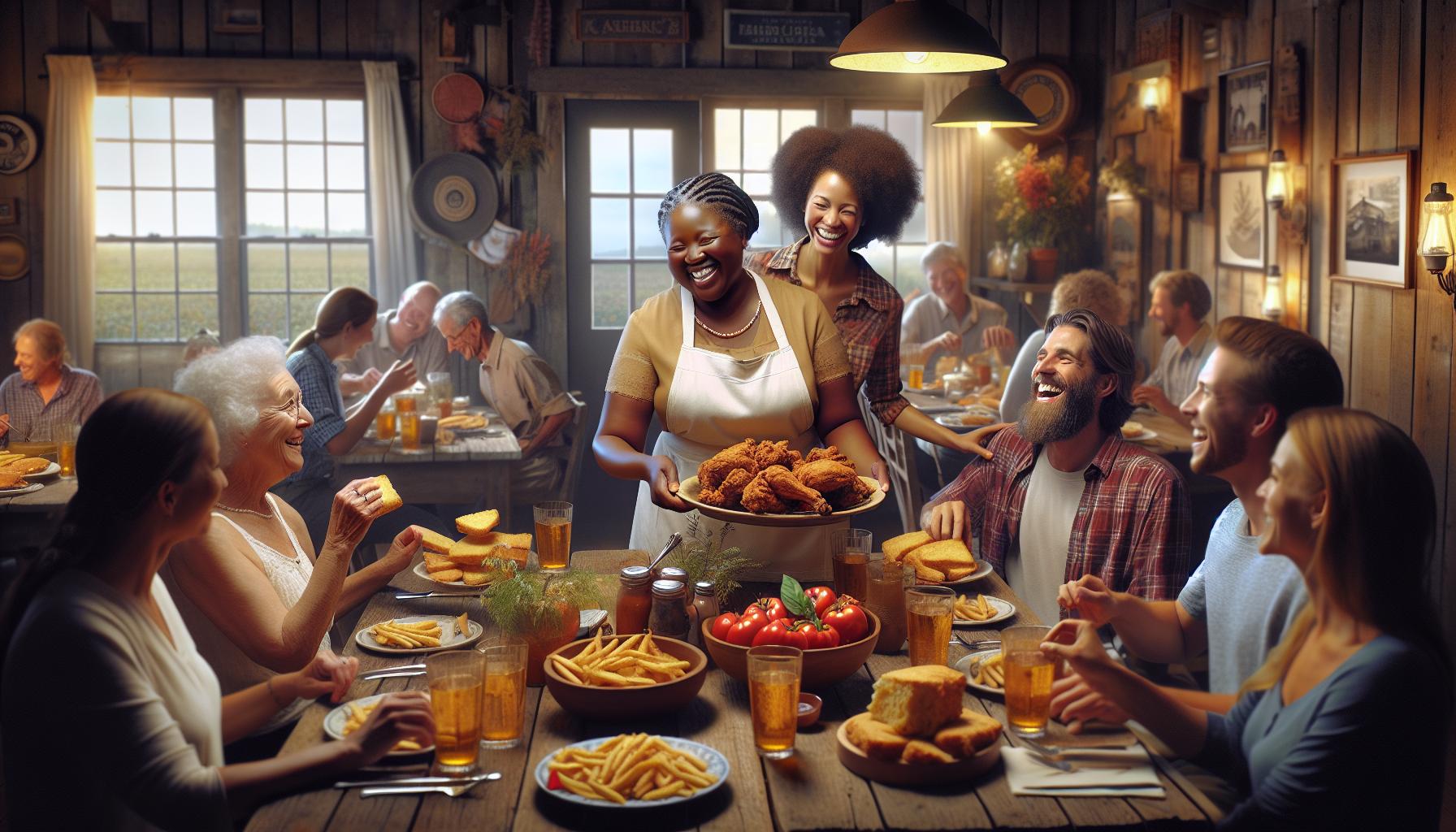Physical Address
304 North Cardinal St.
Dorchester Center, MA 02124

American food culture stands as a melting pot of flavors where hamburgers meet apple pie and food trucks mingle with fine dining establishments. From coast to coast this vast nation serves up a diverse menu that reflects its multicultural heritage and innovative spirit. The American dining landscape has evolved from simple colonial fare to a sophisticated fusion of global influences.
Today’s American food scene is a fascinating mix of traditional comfort foods regional specialties and modern culinary innovations. Whether it’s Southern soul food New England seafood or Southwestern tex-mex Americans have embraced a “bigger is better” philosophy that’s evident in portion sizes and bold flavors. Fast food culture may have been born here but farm-to-table movements and health-conscious dining trends now shape how Americans think about their meals.
American food culture traces a dynamic path from indigenous traditions through waves of immigration to modern fusion cuisine. The transformation spans centuries of cultural exchange food preservation innovations rapid urbanization.
Native American agricultural practices introduced crucial crops like corn beans squash to colonial settlers. The Three Sisters farming method – planting corn beans squash together – revolutionized sustainable agriculture across North America. Indigenous peoples shared vital food preservation techniques including smoking meats making pemmican drying fruits. Traditional Native American ingredients including maple syrup wild rice cranberries remain staples in modern American cooking. Their hunting gathering practices established regional food patterns that persist in dishes like succotash clambakes barbecue.
European immigrants transformed American cuisine through distinct cooking methods traditional recipes family food customs. German settlers introduced hot dogs pretzels hamburgers while Italian immigrants brought pizza pasta tomato-based sauces. Irish immigrants popularized meat potatoes dishes Eastern European Jews established delicatessen culture in major cities. The influx of immigrants in the 1800s created ethnic neighborhoods where traditional foods evolved into American variants. These culinary traditions merged with local ingredients creating distinctive regional cuisines like New England seafood dishes Southern comfort food Midwest casseroles.
| Immigration Wave | Key Food Contributions |
|---|---|
| German (1850s) | Hot dogs, hamburgers, beer culture |
| Italian (1880s) | Pizza, pasta, espresso |
| Irish (1840s) | Corned beef, potato dishes |
| Jewish (1880s) | Delicatessen, bagels, pickled foods |

American cuisine varies distinctly by geographical region, reflecting local ingredients, historical influences, and cultural heritage. Each area maintains unique cooking methods, signature dishes, and flavor profiles that contribute to the nation’s diverse food landscape.
Southern soul food encompasses hearty dishes rooted in African American culinary traditions. Crispy fried chicken represents a cornerstone of Southern cooking, accompanied by cornbread made in seasoned cast iron skillets. Black-eyed peas, collard greens, and okra feature prominently in traditional recipes, often cooked with smoked ham hocks or bacon fat for enhanced flavor. Mac and cheese serves as a staple side dish, prepared with sharp cheddar and a golden-brown crust. Sweet potato pie, peach cobbler, and banana pudding showcase the region’s approach to desserts, combining fresh ingredients with time-honored preparation methods.
Midwestern cuisine centers on hearty, farm-fresh ingredients and German-Scandinavian influences. Hot dishes combine ground beef, vegetables, and tater tots in casserole form, serving as practical one-pan meals. Fresh dairy products appear in cheese curds, butter burgers, and creamy pasta dishes. The region’s grain production influences specialties like Chicago deep-dish pizza’s thick cornmeal crust and Milwaukee’s beer-based recipes. Traditional dishes include Cincinnati chili served over spaghetti, St. Louis-style ribs, and Detroit-style square pizza.
Coastal regions feature seafood-centric dishes that reflect their maritime heritage. New England clam chowder combines fresh clams, potatoes, and cream in a signature white base. Maine lobster rolls showcase sweet meat on buttered rolls, while Maryland blue crab feasts include Old Bay seasoning and newspaper-covered tables. Pacific Northwest cuisine centers on wild-caught salmon, Dungeness crab, and fresh oysters. Florida’s coastal menu includes fresh grouper sandwiches, stone crab claws, and Key lime pie made with local citrus.
The fast food industry transformed American dining habits in the mid-20th century. This revolution redefined convenience eating culture through standardized menus, quick service models, and affordable pricing.
Drive-through restaurants emerged in the 1940s, pioneered by chains like In-N-Out Burger in California. The concept gained momentum in the 1950s when McDonald’s streamlined its menu to focus on burgers, fries, and shakes, serving them in under 60 seconds. Drive-through operations expanded rapidly during the 1960s, coinciding with America’s growing car culture and suburban development. The introduction of advanced ordering systems in the 1970s increased efficiency, enabling chains to serve up to 150 cars per hour. Modern drive-throughs account for 70% of fast food sales, processing over 6 billion orders annually across 200,000 U.S. locations.
American fast food chains dominate the global food service industry, operating in more than 100 countries. McDonald’s leads with 39,000 international locations, followed by KFC with 25,000 restaurants worldwide. These chains adapt their menus to local tastes while maintaining core American offerings. Pizza Hut serves curry pizza in India while Burger King offers rice burgers in Asian markets. U.S. fast food corporations generate $200 billion in annual global revenue, employing over 4 million people internationally. The expansion created standardized food expectations across cultures, introducing American-style burgers, fries, and soft drinks to diverse global markets.
Modern American cuisine embraces sustainability, diversity and innovation through emerging culinary movements that reshape dining habits nationwide. Contemporary food culture reflects growing consumer awareness about food sourcing, preparation methods and global flavors.
The farm-to-table movement connects consumers directly with local food producers and emphasizes seasonal ingredients harvested at peak freshness. Local farmers markets increased from 1,755 locations in 1994 to over 8,600 in 2023, demonstrating widespread adoption of sustainable food practices. Restaurants source ingredients from farms within 100-150 miles to reduce transportation impact and support regional agriculture. Popular farm-to-table dishes include heirloom tomato salads, grass-fed beef entrees and locally foraged mushroom plates. This movement promotes environmental stewardship through reduced food miles, sustainable farming practices and elimination of artificial preservatives.
American fusion cuisine combines culinary traditions to create innovative dishes that reflect the nation’s multicultural identity. Korean-Mexican tacos, Japanese-Peruvian sushi rolls and Indian-Chinese noodles exemplify creative flavor combinations gaining popularity in urban dining scenes. Modern chefs integrate traditional cooking techniques with contemporary ingredients, creating dishes like kimchi hamburgers, wasabi mashed potatoes and curry pizza. Social media platforms accelerate fusion food trends, with viral dishes generating millions of views and inspiring restaurant menu additions. Food halls in major cities showcase diverse fusion concepts under one roof, allowing diners to experience multiple cultural combinations in a single location.
American dining culture emphasizes social connections through shared meals at home dining tables restaurants. Social gatherings around food serve as focal points for celebrations family bonds community engagement.
American families preserve culinary traditions through weekly rituals like Sunday dinners holiday feasts. The typical American family shares 3-4 meals together per week with dinner remaining the primary gathering time. Traditional celebrations include Thanksgiving dinner which brings extended families together to share turkey stuffing cranberry sauce pumpkin pie. Holiday cookie baking sessions engage multiple generations in creating family recipes passed down through generations. Regular weekend barbecues unite neighbors friends during summer months featuring grilled meats side dishes potluck contributions.
American restaurants function as social hubs serving 70 billion meals annually across 1 million establishments. Dining out occurs 5.6 times per week for the average American creating spaces for business meetings social gatherings celebrations. Restaurants offer diverse experiences from casual diners featuring booth seating communal tables to upscale establishments providing intimate dining spaces. Popular dining formats include:
Restaurants accommodate varying group sizes with 65% offering flexible seating arrangements for parties of 2-20 people.
American food culture continues to evolve with emerging trends that prioritize sustainability environmental consciousness cultural fusion. These shifts reflect changing consumer preferences technological advancements changing demographics.
Sustainable food practices shape modern American dining through vertical farming regenerative agriculture zero-waste initiatives. Indoor farming technologies enable year-round production of fresh produce reducing transportation emissions by 95%. Agricultural technology companies integrate AI-powered systems to optimize crop yields reduce water usage by 75%. Restaurant chains adopt transparent sourcing practices with QR code tracking systems linking customers directly to farm origins. Leading retailers implement blockchain technology to trace food products from farm to table verifying sustainability claims. Urban farming initiatives transform 15,000 vacant lots into productive gardens supplying fresh produce to local communities.
Digital platforms connect diverse food communities creating new fusion possibilities across American kitchens. Virtual cooking classes link home cooks with international chefs expanding cultural understanding through shared recipes techniques. Food delivery apps feature specialized sections for authentic ethnic cuisines increasing accessibility to diverse food options. Social media platforms showcase 250,000 daily food-related posts introducing traditional dishes to new audiences. Restaurant incubators support immigrant entrepreneurs launching 500 new multicultural establishments annually. Food halls dedicate 60% of their spaces to international vendors creating immersive dining experiences. Technology enables real-time translation of menus recipes bridging language barriers in culinary exploration.
American food culture stands as a testament to the nation’s dynamic identity. It’s a living tapestry woven from diverse influences ranging from indigenous traditions to modern fusion cuisine. What started as simple colonial fare has evolved into a sophisticated culinary landscape that embraces both time-honored recipes and innovative cooking trends.
The future of American cuisine continues to evolve through sustainable practices technological innovations and multicultural influences. This rich food heritage doesn’t just reflect what Americans eat – it tells the story of who they are as a nation. Today’s American food scene proves that the kitchen table remains a powerful force for cultural expression community building and social change.